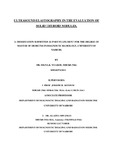| dc.contributor.author | Nyakoe, Diana K | |
| dc.date.accessioned | 2016-04-21T05:40:50Z | |
| dc.date.available | 2016-04-21T05:40:50Z | |
| dc.date.issued | 2015 | |
| dc.identifier.uri | http://hdl.handle.net/11295/94435 | |
| dc.description.abstract | Introduction: Ultrasound elastography has recently emerged as a dynamic technique that
uses high resolution ultrasonography to provide an estimation of tissue stiffness by measuring
the degree of distortion under the application of an external force.
Objective: The aim of this study was to evaluate the diagnostic accuracy of ultrasound
elastography in the differentiation of malignant and benign thyroid nodules, using fine needle
aspiration cytology as a standard reference.
Study Design: A prospective cross-sectional study.
Setting: Kenyatta National Hospital and University of Nairobi, Department of Diagnostic
Imaging and Radiation Medicine (DDIRM),
Sample Size: A total of 84 patients were evaluated over a period of 6 months, from July 2014
to December 2014.
Materials and Methods:
Study subjects:Patients from KNH thyroid clinic who had a provisional diagnosis of nodular
thyroid disease and fulfilled the inclusion criteria for the study.
Ethical considerations: Ethical approval and clearance was obtained from the KNH-UON
Ethics Review Board.
Methodology: Conventional B-mode ultrasonography and ultrasound elastography was done
on solid thyroid nodules. Ultrasound elastography included an elastography colour scale
score system (1 to 5) and offline acquisition of stain ratios (cutoff of greater than or equal to 4
as malignant). Correlation with fine needle aspiration cytology/ histopathology was
subsequently done. A data collection form was used to record all the relevant data.
Statistical analysis: Data analysis was performed using the STATA version 12. Statistical
significance was set at p < 0.05.
Results: A total of 173 solid thyroid nodules in 84 patients were examined. Majority, 72/84
(85.7%) were females, while 12/84 (14.3%) were males. The median age range was 40 to 50
years. Most patients presented with multiple thyroid nodules, 53/84 (63%).
x
Elastography scores of 1 to 3 produced 124 true negative (benign) cases, while elastography
scores 4 and 5 revealed 39 true positive (malignant) cases on FNA/Histopathology.
Sensitivity of 0.91 and specificity of 0.97 was obtained using the elastography score system
for thyroid cancer diagnosis. Positive predictive value of 90.9% and Negative predictive
value of 96.9%. Diagnostic accuracy of the technique was 93.17%.
Strain ratio acquisitions for the same thyroid nodules revealed a sensitivity of 0.89 and
specificity of 0.96, positive predictive value of 88.6% and Negative predictive value of
96.1% in the differential diagnosis of benign and malignant thyroid nodules. However, there
were 5 false positive and 5 false negative findings which markedly reduced the reliability of
elastography.
Conclusion:
This study has shown that ultrasound elastography has no added benefit in determining
whether a thyroid nodule is likely malignant and the final diagnosis should solely depend on
FNA cytology and histopathology findings. | en_US |
| dc.language.iso | en | en_US |
| dc.publisher | University of Nairobi | en_US |
| dc.subject | evaluation of solid thyroid nodules. | en_US |
| dc.title | Ultrasound elastography in the evaluation of solid thyroid nodules. | en_US |
| dc.type | Thesis | en_US |
| dc.description.department | a
Department of Psychiatry, University of Nairobi, ; bDepartment of Mental Health, School of Medicine,
Moi University, Eldoret, Kenya | |

